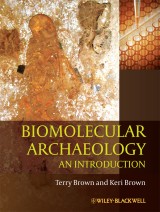Details

Biomolecular Archaeology
An Introduction1. Aufl.
|
39,99 € |
|
| Verlag: | Wiley-Blackwell |
| Format: | EPUB |
| Veröffentl.: | 08.02.2011 |
| ISBN/EAN: | 9781444392432 |
| Sprache: | englisch |
| Anzahl Seiten: | 336 |
DRM-geschütztes eBook, Sie benötigen z.B. Adobe Digital Editions und eine Adobe ID zum Lesen.
Beschreibungen
<p>Illustrated thoroughly, <i>Biomolecular Archaeology</i> is the first book to clearly guide students through the study of ancient DNA: how to analyze biomolecular evidence (DNA, proteins, lipids and carbohydrates) to address important archaeological questions.</p> <ul> <li>The first book to address the scope and methods of this new cross-disciplinary area of research for archaeologists</li> <li>Offers a completely up-to-date overview of the latest research in this innovative subject</li> <li>Guides students who wish to become biomolecular archaeologists through the complexities of both the scientific methods and archaeological goals.</li> <li>Provides an essential component to undergraduate and graduate archaeological research</li> </ul>
List of Figures. <p>List of Tables.</p> <p>Preface.</p> <p><b>Part I: Biomolecules and How They Are Studied.</b></p> <p>Chapter 1 What is Biomolecular Archaeology?</p> <p>Chapter 2 DNA.</p> <p>Chapter 3 Proteins.</p> <p>Chapter 4 Lipids.</p> <p>Chapter 5 Carbohydrates.</p> <p>Chapter 6 Stable Isotopes.</p> <p><b>Part II: Preservation and Decay of Biomolecules in Archaeological Specimens.</b></p> <p>Chapter 7 Sources of Ancient Biomolecules.</p> <p>Chapter 8 Degradation of Ancient Biomolecules.</p> <p>Chapter 9 The Technical Challenges of Biomolecular Archaeology.</p> <p><b>Part III: The Applications of Biomolecular Archaeology.</b></p> <p>Chapter 10 Identifying the Sex of Human Remains.</p> <p>Chapter 11 Identifying the Kinship Relationships of Human Remains.</p> <p>Chapter 12 Studying the Diets of Past People.</p> <p>Chapter 13 Studying the Origins and Spread of Agriculture.</p> <p>Chapter 14 Studying Prehistoric Technology.</p> <p>Chapter 15 Studying Disease in the Past.</p> <p>Chapter 16 Studying the Origins and Migrations of Early Modern Humans.</p> <p>Glossary.</p> <p>Index.</p>
<b>Terry Brown</b> is Professor of Biomolecular Archaeology at The University of Manchester. His publications include <i>Gene Cloning and DNA Analysis: An Introduction</i> (6th edition, Blackwell Science, 2010) and <i>Genomes</i> (3rd edition, 2006). <p><b>Keri Brown</b> is Honorary Lecturer in Biomolecular Archaeology at the University of Manchester; she taught the M.Sc in Biomolecular Archaeology at Manchester and Sheffield Universities for 10 years. She has published articles in both Italian archaeology and ancient DNA.</p>
<i>Biomolecular Archaeology</i> investigates how biomolecular evidence (DNA, proteins, lipids and carbohydrates) can be used to address important archaeological questions. Terry Brown and Keri Brown describe this remarkable revolution in the study of historic and prehistoric biological materials, and provide the fundamental tools for studying the preserved or ‘ancient’ biomolecules recovered from human, plant, and animal remains. <p>A clear guide for students and an excellent resource for researchers, <i>Biomolecular Archaeology</i> illustrates a variety of analytical techniques taken from evolutionary biology, such as PCR, proteomics, and image analysis; and from chemistry, such as mass spectrometry and isotope analysis. With this new array of DNA evidence, the authors demonstrate how researchers can recover valuable information about the evolution of human societies and the environments in which we live.</p>
<p>"This book is a perfect introduction into biomolecular archaeology not only for students interested in the field but also for experienced archaeologists, palaeontologists and archaeobiologists who engage in interdisciplinary research involving the analysis of biomolecules. It is written by one of the most prominent genomic textbook authors, Terry Brown, a pioneer in ancient DNA research and the origins of plant domestication. In this book, his qualities as both an excellent textbook writer as well as a brilliant molecular biologist merge to explain even the most advanced sequencing methods used in palaeogenomics in a way that is understandable for non-experts. The contribution of Keri Brown ensures that the book is relevant to researchers working in the field. <i>Biomolecular Archaeology</i> makes for an ideal manual for archaeologists and students eager to exploit the newest scientific developments to answer typical archaeological questions and better interpret the information buried in the archaeological sites they are working on."<br />—<b>Eva-Maria Geigl, Université Paris Diderot</b></p> <p>"The study of ancient and extant biomolecules has revolutionized archaeological methodologies. This textbook is an excellent, user-friendly introduction to biomolecular techniques and applications for beginning students in archaeology and physical anthropology."<br />—<b>Linda Stone, Professor Emeritus of Anthropology, Washington State University</b></p> <p>"This is a timely and welcome contribution to the rapidly developing field of biomolecular archaeology, covering the basic science as well as an introduction to the applications. It will become essential reading."<br />—<b>A.M. Pollard, University of Oxford</b></p> <p>"There are fewer and fewer areas of archaeology which are immune to biomolecular analysis. Technological innovation combined with a greater understanding of molecular survival has increased reliability of analyses and interpretation, making biomolecular research amongst the fastest moving and most exciting areas in modern archaeology. This book, helped by its easy and accessible style, leads the reader in a logical progression from the molecules themselves to their application in the study of demography, diet, innovation and migration; it should be recommended reading for all new students of archaeology."<br />—<b>Matthew Collins, University of York</b></p> <p>"The authors have done a stupendous job, with the scientific nature of DNA and other biomolecular studies understandable for archaeologists, and the archaeological applications of these methods clear to all."<br />—<b>Robert Tykot, University of South Florida</b></p>


















